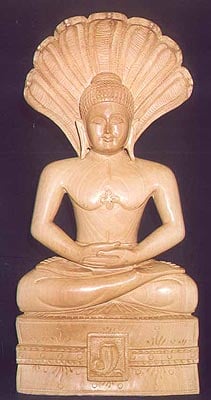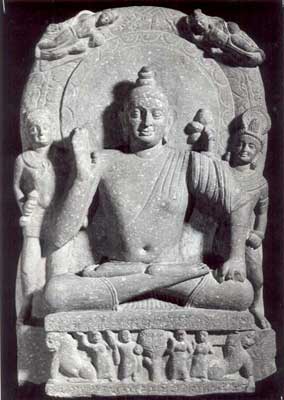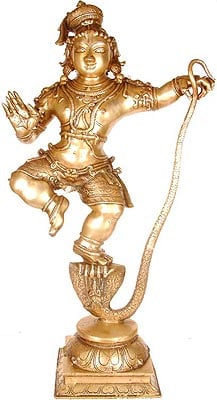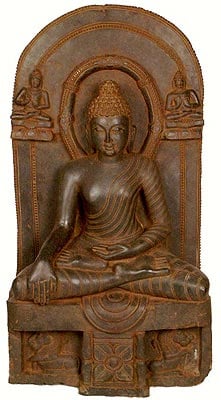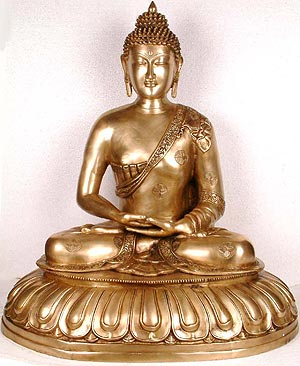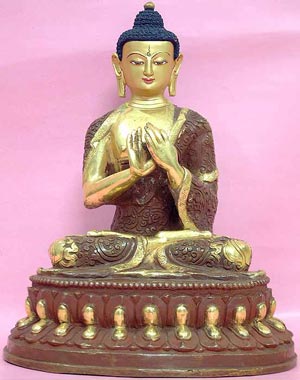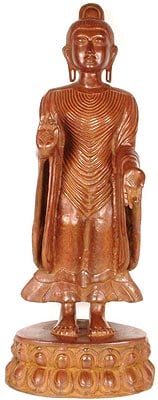The Buddha image, without which the sculptural art of South Asia would have been deprived not only of its major bulk but also much of its stylistic versatility and spiritual fervor, has constantly been under debate as to its origin and evolution. Some believe that the first Buddha image had come into being during the lifetime of the Buddha himself. These scholars contend that the tradition so begun continued ever since, but the medium, wood or clay, generally used for making these images, being of perishable nature, could not have such images survive against time.
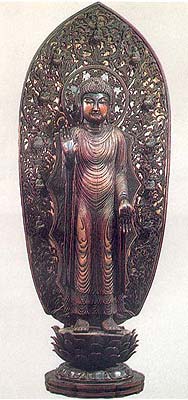 The Image of Shakyamuni Buddha from Seiryoji, Kyoto, Japan, AD 987, said to be based on king Udayana's first image of Buddha. |
The legend of king Udayana, which appears in the Chinese version of the Anguttara Nikaya, supports this view. This text of the Anguttara Nikaya, translated into Chinese sometime between the first and the third century A.D. from a Korean translation of the scripture, obviously a work of an earlier date, contends that the Buddha, after he was Enlightened, wished to sermonize his mother Maya who, having passed away, was in the Trayatrimsa heaven (Realm of the thirty-three gods). Buddha hence left this world for three months and went there. To king Udayana his absence was unbearable. He thus commissioned his image. After three months, Buddha descended back from Trayatrimsa. According to the legend, king Udayana, on his return, showed the image to the Buddha who thereupon preached the great virtue of making the Buddha image.
This story of king Udayana commissioning the Buddha image is said to have been recorded also by Fa-hsien and later by Hsuan Tsang in their travel accounts. One of the most sacred Buddha images in Japan is revered as being the replica of the above-mentioned king Udayana's Buddha image. This image was acclaimedly brought from China to Japan in 986 A.D. by a Japanese Buddhist monk Chonen.
The first Buddha image was made of sandalwood. Adhering to tradition, the Japanese replica is worshipped by offering pouches of sandalwood powder. This legend of the origin of the Buddha image is yet prevalent and largely believed in Tibet, China and Japan.
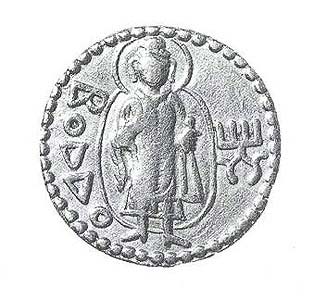 One of the earliest surviving Buddha image. Kushana Dynasty Gold Coin with Standing Buddha on the reverse: circa 100 B.C. |
For most scholars however, logically basing their opinions on the antiquity of available art objects, the earliest Buddha images come from around the first century B.C., some five hundred year after Buddha's Mahaparinirvana. These occur on Kushana dynasty coins datable to 150 to 50 B.C. having human figures on them, which some identify as the Buddha.
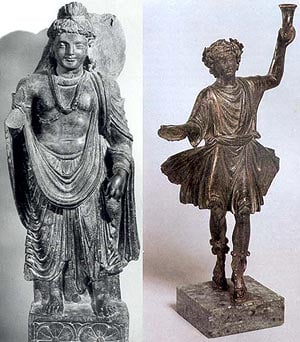
|
The image proper makes its appearance only later, around the first century of the Christian era. These first Buddha images show an abundance of Hellenistic elements and thus it is in the images of the Greek god Apollo that their proto form is conjectured.
The absence of the Buddha image in early Buddhist art has been as diversely interpreted. It is largely believed that the Buddha had himself prohibited his images, though this view is little supported by Buddhist literature. J. C. Huntington, who claims that the Buddha image had come into being in Buddha's own lifetime, quotes a passage from the Vinaya of the Sarvastivadins in his Studies in Buddhist Art of South Asia under "The Origin of the Buddha Image". The passage is an indirect injunction against his image making, but the words used in it comprise as much a sanction for it. In the passage, Anathapindika asks the Great Lord," World honored one, if images of yours are not allowed to be made, pray, may we not at least make images of Bodhisattvas in attendance upon you?" The Buddha gives his assent to it.
In the Buddhist vision, the primary virtue has necessarily been compassion. Surely, the highest embodiment of compassion was one who had struggled through numerous rebirths towards the liberation that was nirvana, and on reaching the desired threshold, turned back to regard living beings with an all-embracing compassion, and then willingly reentered samsara in order to help the whole world achieve enlightenment. Such a being was termed a bodhisattva. Siddhartha Gautama himself had therefore been a bodhisattva for the thirty-five years prior to his enlightenment, when he became the Buddha. Indeed, early images of Siddhartha shortly before his enlightenment are accordingly often termed 'bodhisattva.'
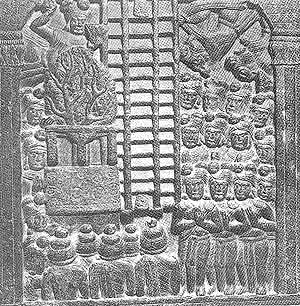 Worship of the Empty Throne and Bodhi tree: Sanchi, 2nd - 1st century B.C |
Nevertheless, the theory that the Buddha had disallowed his images is more prevalent. A large group of scholars supporting it contend that early Buddhist art, after the image making had been prohibited, resorted to symbolism for representing the Buddha. Instead of reproducing the Great Master in iconic forms, it sought to represent him by a number of symbols, or material motifs, which had remained associated with him. These included the empty throne, Buddha-pada, umbrella or the chatra, stupa, Bodhi-tree, wheel of Law or the Dharma-chakra Triratna, and animal motifs like the elephant and horse.
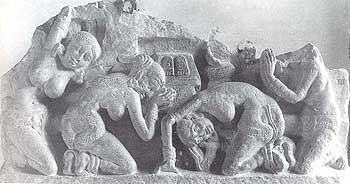 Women Adoring Buddha's Footprints: Amaravati, 1st century B.C. to 1st century A.D. |
A comparatively more recent theory perceives the entire phenomenon from an absolutely different angle. The early Buddhist art, according to this thesis, depicted the Buddha neither in icons nor through symbols. The sculptures from Bharhut, Sanchi, Amaravati and other ancient sites, which comprise this phase, depict episodes from Buddha's life but evade his iconic representations. The motifs, or the so-called symbols, which these panels use in Buddha's place, do not depict his presence, as none of them, except the Buddha-pada (Buddha's feet), is part of his person.
These motifs, the empty throne and stupa in particular, depicted rather, and with utmost thrust, only Buddha's absence, as it was in his absence that his devotees realized the presence of their Master. They further claim that the non-depiction of the Buddha in icons was inspired by monotheism and iconoclasm, which dominated the then world mind, and Buddhism, too, was influenced by it. They, hence, dismiss the idea of realizing him even in symbols as this too amounted to idolatry, which Buddhism did not allow. In this matter, they equate Buddhism with Zoroastrianism, Judaism, Christianity, Islam and Sikhism.
The Issues that Evolve From Amidst These Conflicting Views
Amidst these conflicting views a few things are obvious. Firstly, the tradition of faith and its legends take the date of the Buddha image back to Buddha's lifetime, but the actual Buddha images, which have been recovered so far, date around the beginning of the Christian era. Secondly, the absence of the Buddha image in early Buddhist art was due to some kind of injunction against image making, but the Buddhist texts little support this assumption. Thirdly, admittedly, for some centuries after Buddha's Mahaparinirvana, his images were not made, but there did prevail a cult of worship in the Buddhist tradition, or at least Buddhism may not be termed as iconoclastic. Fourthly, it may hardly be acceptable that the Buddha image is born only of a particular sculptural tradition or is an extension of the other, but, despite, it is obvious that there has been in India and beyond a long and early tradition of image making and idol worship and also that the Buddhist iconography assimilated many of their elements.
Two Phases of Buddhist Art
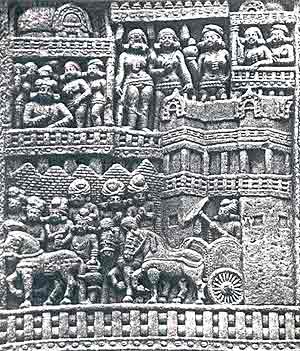 Buddha visiting the city of Kapilavastu: Sanchi, 2nd - 1st century B.C. |
Whatever of the Buddhist art survives today is divisible broadly into two phases, the early (4th century BC - 1st century AD) and the late (1st century onwards). The early phase may be identified as pre-iconic and the late as post iconic. The sculptural panels at Sanchi stupas, carvings in a couple of caves at Ajanta and the remains from Amaravati and other ancient sites define the pre-iconic phase of the Buddhist art. The art of this early phase comprises of the renditions, which depict events and episodes from the life of Buddha, various stages of his attainment of Enlightenment and preaching of Dharma, but such narratives do not have any of his iconic representations.
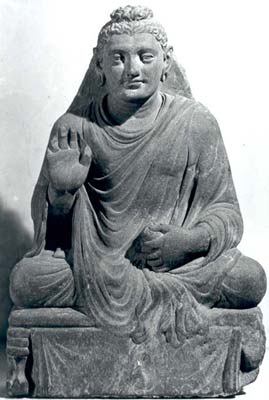 Buddha Image: Kushana style: 2nd century A.D. |
It is only during the second phase of Buddhist art that the anthropomorphic images of the Buddha and Bodhisattvas appear.
 Worship of Stupa: Sanchi, 2nd - 1st century B.C |
As for the claim that Buddha's images were made even during the early phase, or during Buddha's lifetime, there are some strong factors that support this assumption. Buddhist literature, though literalism has little relevance, does not have a single story or detail wherein the Buddha is not physically present. Legends and literary sources speak of Buddha's images being made in his own lifetime. A direct injunction against image making is not on record. Several sculptural panels, mentioned before, depict devotees engaged in worshipping a stupa, the Bodhi-tree, an empty throne etceteras, which suggests that Buddhism did not disallow the worship of 'form'.
And, finally, the Buddhist sculptor had acquired by then great skill in casting anatomical dimensions with utmost accuracy, rendering minute narrative details, infusing 'bhava', or emotionality into his figures and in the depiction of a highly sophisticated symbolism. In any art tradition, these features define the highest stage of skill and aesthetic perception. The art of this phase reveals not only the skill of hands but also the absolute devotion of a mind. As such, it seems improbable that the sculptor, who wove around the Master each detail of his life so devotedly, could check his hands from depicting the Master himself.
 Mahabhinishkramana, or the Great Departure. The attendant besides the empty horse holds an umbrella (now broken): Satavahana, 2nd century B.C. |
The factual position, as the surviving sculptures reveal, is, however, different from this hypothesis. This early art depicts details of the Buddha's life but evades using his iconic image in them. This omission of his personal icon is not casual but well considered. In each narration, one of the motifs, which once formed the part of the rendered episode, occupies the space, which, according to the theme, Buddha's icon should have occupied. For example, the sculptural panel depicting Mahabhinishkramana, or the Great Departure, at Sanchi, has every detail related to the event except the figure of Gautam, the would-be Sakyamuni Buddha. In his place the sculptor has carved a horse without rider, obviously Buddha's horse Kanthaka. The horse has by its side an attendant holding an umbrella, or chhatra, which is suggestive of its links with the Great Lord, but the same horse, when depicted returning after Gautam has renounced the world and consequently the horse also, is without the umbrella. Obviously, the replacement of Buddha's icon with the motif of the horse was well considered and not a casualty.
Merits of Conflicting Opinions
Thus, whatever the legends or arguments, Buddhist art, in its first phase, is marked by the absence of Buddha's anthropomorphic representations.
 Worship of the Prayer Wheel (Dharmachakra): Sanchi, 2nd - 1st century B.C. |
But the theory of Buddha's symbolic, instead of the anthropomorphic, representation is as little convincing. If the Buddha could be represented through symbols, he could as well be represented in icons. When his symbolic manifestation could be installed and worshipped, there could be nothing objectionable in worshipping his personified manifestation. Besides, the motifs used in his place - horse, umbrella, empty throne, Triratna, stupa etceteras, may not be treated as representing him symbolically, because each one has been used to communicate itself and not for symbolizing any other thing. For example, the horse Kanthaka, depicted in the Mahabhinishkramana panel, does not symbolize Buddha. It is only Buddha's horse Kanthaka. It, at the most, reminds of one of the cardinal events of his life, namely his renunciation of material life. Similarly, the stupa celebrates the specific event of Buddha's Parinirvana, and the tri-ratna signify the three jewels of Buddhism, the Buddha, Sangha, and the Dharma.
A theory discovering Buddha's presence in the depiction of his absence is a psychology based assumption. It has been argued that absence, when depicted powerfully, as powerfully reminds of the absent one and thus the absence itself becomes his presence. This dimension of the absence is quite valid in context to the personally known persons. The Buddha, after he was Enlightened, moved from one place to the other and taught the Dharma for long forty years. Thousands of his devotees had the divine experience of seeing the Great Master. Truly, such ones could realise him even in his absence. But, this is a psychological perception, not the vision of a sculptor working with stone as his medium. The sculptor does not convert a materially present phenomenon into a non-presence. He, on the contrary, discovers the non-present into the visual medium and material forms. Besides, such stylistic excellence or innovation could not be a unanimous or universal feature to prevail for over five hundred years.
 Yaksha Figure from Patna: 2nd century B.C. |
The theory that the Buddha, in tune with the monotheistic and iconoclastic trends, which dominated the concurrent world, forbade making of his image, has hardly any substance. Buddha's concurrent world, as becomes evident from various 5th-4th century B.C. Yaksha images, recovered from Bihar, and of a little later period from Mathura, tended more towards idol worship.
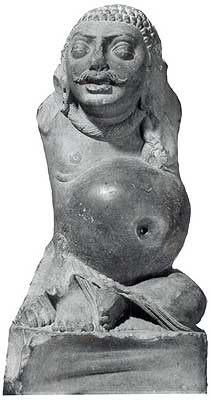 Kuber, one of the four Yaksha guardians of four directions. |
The cult of worshipping Nagas and Yaksha seems to have prevailed in China, Ceylon and other countries also. Jain, and Buddhist literature and the Great Epics repeatedly refer to various Nagas and Yakshas and the Yaksha-chaityas. The Ramayana talks of Yakshattva, a virtue which even gods aspired to attain. Upala was one of the Yaksha related epithets of high honor. Buddha's devotees, out of reverence, called him Upala. Four Lokapalas, the guardian deities of four directions, were Yakshas, Kuber being one of them. Sakyas, Buddha's own clan, had its Yaksha deity, Yaksha Sakya-Vardhana.
 The new-born Siddhartha being offered to Yaksha Sakya-Vardhana. |
Baby Buddha, soon after his birth, was first offered to this same Yaksha deity.
Yakshas and Nagas seem to have so much dominated the scene that all sects, including Buddhism, Jainism and Upanishadas, which initially practised idol-less worship, thought it better to conciliate with them. Each in its own way accommodated Yakshas and Nagas in its system, though invariably by subordinating them to it. Significantly, Parshvanatha, Jains' twenty-third Tirthankara, born some two hundred years before the Buddha, had a Naga, represented as serpent in iconography, to guard him during his penance.
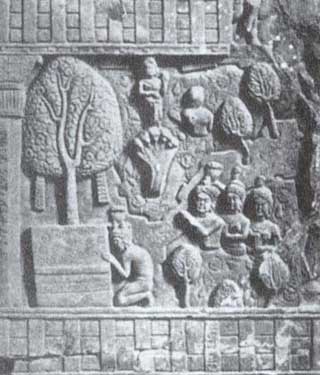 Naga Erapata Worshipping Buddha: Bharhut, Early 1st century BC. |
In Buddhist sculptures Naga Erapata is seen worshipping and Yakha Vajrapani attending upon the Buddha. Shiva, Vishnu, Vasudeo Krishna, all had Nagas and Yakshas associated with them.
|
|
The Bhagavata depicts Krishna subduing Naga Kaliya , The Jatakas describe the Buddha converting many Yakshas to Buddhism.
Now these events stand reduced into mere myths, but are, nonetheless, suggestive of the massive dominance of the Naga and Yaksha cults.
Significantly Buddhism, Jainism or the Upanishadas, did not attempt at dismissing this earlier worship cult, as did other religions around the globe. It is, thus, obvious that the early Buddhism, even when it did not believe in idolatry, was not iconoclastic. It is, hence, difficult to accept the proposition that the prevalent worship cult in Buddha's concurrent world tended towards iconoclasm. It is also too far to go that Buddhist artists, when they subsequently went for Buddha's iconic representations, had to seek their proto-type in Greek images, because concurrent India did not have any of her own tradition of image making.
The Buddhist Tradition from Non-Image to Image
There is no denying the fact that early Buddhist art did not have Buddha's anthropomorphic images. There seems to operate behind it some kind of injunction, but such injunction could not be a one-time taboo-like thing made expressly. In all likelihood, the artists, working as per the Buddhist tradition itself, saw Buddha more in the Dharma rather than in a human form. This tradition begins with Buddha's attainment of Enlightenment. It is a moment of transcendence. The Sakyamuni leaves and the Buddha emerges. With the Light emerges the Buddha and with the Light emerges the Law, the Dharma. Thus, the Buddha is the Dharma and the Dharma is the Buddha, and there is nothing that divides them. The Buddha, before he merged into Dharma, was a living organism, the jeeva-kaya, whatever its name, Gautam, Bodhisattva or Sakyamuni. After he was the Enlightened One, the Buddha, an entity beyond death and birth, beyond time and space, he was the pure existence, the imperishable Dharma-kaya. The anthropometry could span and the art could depict the jeeva-kaya but not the Dharma-kaya, which was beyond both.
This also explains why the Buddha allows Anathapindika (in the Vinaya of Sarvastivadins) for making the images of Bodhisattvas, as the Bodhisattvas represented but the jeeva-kaya. The Dharma-kaya, the fragrance of the Law, could not be translated into a form. In Samyutta Nikaya (iii, 120), the Buddha says," who sees Dharma, sees me, who sees me sees Dharma". The Buddha thus equated the Dharma with the Buddha. The Buddha probably wished to be seen in the Dharma, and not individually. Thus, after the Buddha and the Dharma were one, an image, a thing perishable and with little expanse, could not represent him, for the image could capture his anatomy but not him who as Dharma was a reality beyond time and space. The ocean could not be contained in a bowl.
The Unity of The Buddha and The Dharma in Buddhist Iconography
Even during the subsequent late phase, when Buddha's anthropomorphic images were made in abundance, this perception of seeing Buddha in the Dharma and the Dharma in the Buddha, pervades the Buddhist art scenario. Not a single Buddha image, not even one of his votive statues, has so far come to light, which does not depict one aspect or the other of the Dharma. Each one is seen imbued with the spiritual fervor of the Dharma. It does not so much portray the Buddha as it does the Dharma, The later treatises formulate definite rules in this regard. For example, images for the sanctum sanctorum were required to depict primarily one of the Four Cardinal Stages in the attainment of Buddhahood. These are:
1). Buddha in the Bhumisparsha Mudra: Signifying the Buddha on the verge of enlightenment.
2). Buddha in the Dhyana Mudra: Buddha's realization of Dharma in which meditation played a significant part.
3). Dharmachakra Mudra: Buddha's first sermon at Sarnath and the initiation of Dharma.
4). Walking Buddha: Buddha's energetic and dynamic propagation of the Dharma, by traversing the length and breadth of the land.
The Lankavatara Sutra commands the artist to paint beyond the aesthetic surfaces 'the picture that is not in color's, that is, Buddha's right iconography shall evolve only when the sculptor portrayed the spiritual dimensions of his being which was the Dharma.
This Buddhist art vision repeatedly appears in texts. The Divyavadana puts it in the form of a legend. Rudrayana, one of Buddha's royal disciples, desires to have Buddha's portrait, or image. He summons his court artists to make Buddha's portrait. They attempt at making it but are not able to 'grasp' his likeness. Afterwards, the Buddha projects on the canvas his outline or shadow, and instructs to fill it in with colors. It appears, in a yet different manner, in the Uttaratantra of Maitreya (Obermiller's version of it in Acta Orientalia, volume 9, pages 208-209). The text proclaims that none else but only such ones as have imbibed into their beings the charity, morals, patience and the rest, and the highest point of excellence can grasp Buddha's likeness, that is, for grasping his likeness the quality of soul was more important than the skill of hands.
